
Hi Everybody!!
I thought we would begin November with a Blue Jay Day! I have shared links to 2 new blue jay albums and info from Wikipedia (below). You might be wondering why a blue jay's feathers are blue. Truth is they are not blue at all! (You can find out in the info). I have resident blue jays that stay here year round. They have me trained to supply them with peanuts and corn. I try to snap them in motion! I have taught one of the jays a whistle and he responds! Always Amazing-Enjoy!







link:
https://plus.google.com/u/0/photos/117645114459863049265/albums/5939256594163967617

https://en.wikipedia.org/wiki/Blue_Jay
Blue Jay
From Wikipedia, the free encyclopedia
The Blue Jay (Cyanocitta cristata) is a passerine bird in the family Corvidae, native toNorth America. It is resident through most of eastern and central United States and southern Canada, although western populations may be migratory. It breeds in bothdeciduous and coniferous forests, and is common near and in residential areas. It is predominately blue with a white chest and underparts, and a blue crest. It has a black, U-shaped collar around its neck and a black border behind the crest. Sexes are similar in size and plumage, and plumage does not vary throughout the year. Four subspecies of the Blue Jay are recognized.
The Blue Jay mainly feeds on nuts and seeds such as acorns, soft fruits, arthropods, and occasionally small vertebrates. It typically gleans food from trees, shrubs, and the ground, though it sometimes hawks insects from the air. It builds an open cup nest in the branches of a tree, which both sexes participate in constructing. The clutch can contain two to seven eggs, which are blueish or light brown with brown spots. Young are altricial, and are brooded by the female for 8–12 days after hatching. They may remain with their parents for one to two months.
The bird's name derives from its noisy, garrulous nature.[2] It is sometimes called a "jaybird"
| Blue Jay | |
|---|---|
 | |
| Conservation status | |
| Scientific classification | |
| Kingdom: | Animalia |
| Phylum: | Chordata |
| Class: | Aves |
| Order: | Passeriformes |
| Family: | Corvidae |
| Genus: | Cyanocitta |
| Species: | C. cristata |
| Binomial name | |
| Cyanocitta cristata (Linnaeus, 1758) | |
 | |
| Global range. Yellow: breeding only Green: Resident all year Blue: wintering only. See also text for recent range expansion. | |
Behavior[edit]
The Blue Jay is a noisy, bold and aggressive passerine. It is a moderately slow flier (roughly 32–40 km/h (20–25 mph)) when unprovoked.[12] It flies with body and tail held level, with slow wing beats. Due to its slow flying speeds, this species makes easy prey for hawks and owls when flying in open areas. Virtually all the raptorial birds sympatric in distribution with the Blue Jay may predate it, especially swift bird-hunting specialists such as the Accipiter hawks. Diverse predators may predate jay eggs and young up to their fledging stage, including tree squirrels, snakes, cats, crows, raccoons, opossums, other jays and possibly many of the same birds of prey who attack adults.[13]
The Blue Jay can be beneficial to other bird species, as it may chase predatory birds, such as hawks and owls, and will scream if it sees a predator within its territory. It has also been known to sound an alarm call when hawks or other dangers are near, and smaller birds often recognize this call and hide themselves away accordingly. It may occasionally impersonate the calls of raptors, especially those of the Red-tailed and Red-shouldered Hawks, possibly to test if a hawk is in the vicinity, though also possibly to scare off other birds that may compete for food sources.[10] It may also be aggressive towards humans who come close to its nest, and if an owl roosts near the nest during the daytime the Blue Jay mobs it until it takes a new roost. However, Blue Jays have also been known to attack or kill other smaller birds and sleeping, foliage-roosting bat species such as Lasiurus borealis.[14] Jays are very territorial birds, and they will chase others from a feeder for an easier meal. Additionally, the Blue Jay may raid other birds' nests, stealing eggs, chicks, and nests. However, this may not be as common as is typically thought, as only 1% of food matter in one study was compromised by birds.[10]Despite this, other passerines may still mob jays who come within their breeding territories.
Blue Jays, like other corvids, are highly curious and are considered intelligent birds. Young individuals playfully snatch brightly colored or reflective objects, such as bottle caps or pieces of aluminium foil, and carry them around until they lose interest.[14] While not confirmed to have engaged in tool use in the wild, blue jays in captivity have been observed using strips of newspaper as tools to obtain food,[10][15] while captive fledglings have been observed attempting to open the door to their cages [16]
Diet[edit]
Blue Jays have strong black bills which they use for cracking nuts and acorns, usually while holding them with their feet, and for eating corn, grains and seeds. Its food is sought both on the ground and in trees and includes virtually all known types of plant and animal sources, such as acorns and beechmast, weed seeds, grain, fruits and otherberries, peanuts, bread, meat, smallinvertebrates of many types, scraps in town parks, bird-table food and rarely eggs and nestlings.[10] Blue Jays will sometimes cachefood, though to what extent differs widely among individuals.[17] Although seemingly contentious in their general behavior, Blue jays are frequently subservient to other medium-sized birds who visit bird-feeders. InFlorida, Blue jays were dominated at feeders by Eastern gray squirrels, Florida Scrub-Jays, Common Grackles and Red-headed Woodpeckers, all of which were occasionally observed to aggressively prevent the jays from feeding.[10]
Reproduction[edit]
The mating season begins in mid-March, peaks in mid-April to May, and extends into July. Any suitable tree or large bush may be used for nesting, though an evergreen is preferred. The nest is preferentially built at a height in the trees of 3 to 10 m (9.8 to 33 ft). It is cup-shaped and composed of twigs, small roots, bark strips, moss, other plant material, cloth, paper, and feathers, with occasional mud added to the cup.
Blue Jays are not very picky about nesting locations. If no better place is available – e.g. in a heavily deforested area – they will even use places like the large mailboxes typical of the rural United States.[11] They also appropriate nests of other mid-sized songbirds as long as these are placed in suitable spots; American robin nests are commonly used by Blue Jays, for example.
Blue Jays typically form monogamous pair bonds for life. Both sexes build the nest and rear the young, though only the female broods them. The male feeds the female while she is brooding the eggs. There are usually between 3 and 6 (averaging 4 or 5) eggs laid and incubated over 16–18 days. The young fledge usually between 17–21 days after hatching.[14]
After the juveniles fledge, the family travels and forages together until early fall, when the young birds disperse to avoid competition for food during the winter. Sexual maturity is reached after one year of age. Blue jays have been recorded to live for more than 26 years in captivity and one wild jay was found to have been around 17 and a half years old.[18] A more common lifespan for wild birds that survive to adulthood is around 7 years.[citation needed] Beyond predation and the occasional collision with man-made objects, a common cause of mortality in recent decades has been the West Nile Virus, which corvids as a whole seem especially subceptible to. However, despite several major local declines, overall Blue Jays have not seemed to have been depleted by the disease.[13]
Vocalizations[edit]
Blue Jays can make a large variety of sounds, and individuals may vary perceptibly in their calling style. Like other corvids, they may learn to mimic human speech. Blue Jays can also copy the cries of local hawks so well that it is sometimes difficult to tell which it is.[19] Their voice is typical of most jays in being varied, but the most commonly recognized sound is the alarm call, which is a loud, almost gull-like scream. There is also a high-pitched jayer-jayer call that increases in speed as the bird becomes more agitated. This particular call can be easily confused with the chickadee's song because of the slow starting chick-ah-dee-ee. Blue Jays will use these calls to band together to mobpotential predators such as hawks and drive them away from the jays' nests.
 |
|
| Problems playing this file? See media help. | |
Blue Jays also have quiet, almost subliminal calls which they use among themselves in proximity. One of the most distinctive calls of this type is often referred to as the "rusty pump" owing to its squeaky resemblance to the sound of an old hand-operated water pump. The Blue Jay (and other corvids) are distinct from most other songbirds for using their call as a song.
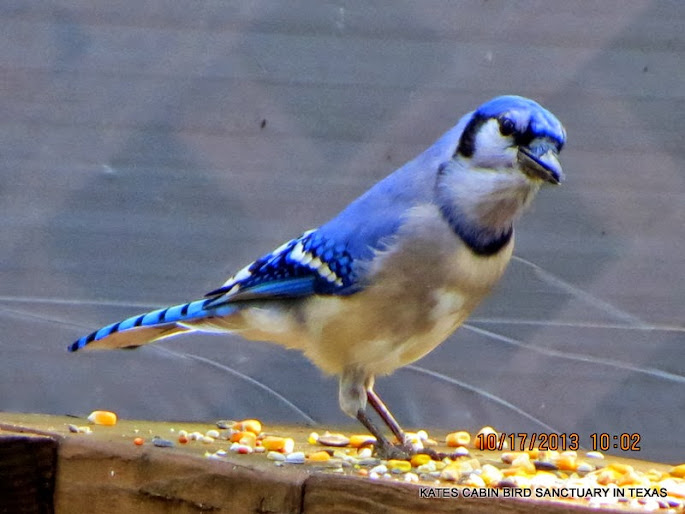






link:
https://plus.google.com/u/0/photos/117645114459863049265/albums/5936897104303958865


...this is brendasue signing off from Rainbow Creek. See You next time! Remember when it is cold outside, the birds are hungry. Help a Bird-You will be repaid!

The Living End!
O+O


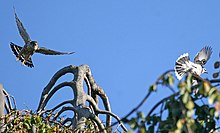

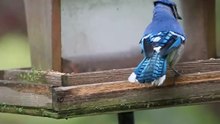
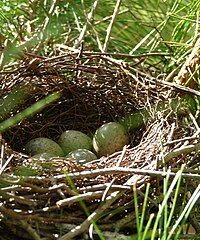
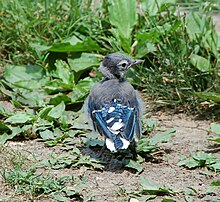

No comments:
Post a Comment
Hi Everybody! Please say hello and follow so I know you are here! Due to the inconsideration of people trying to put commercials on my blog comment area, I have restricted use of anonymous posts. Sorry that some hurt all.
My public email is katescabin@gmail.com No spammers or trolls